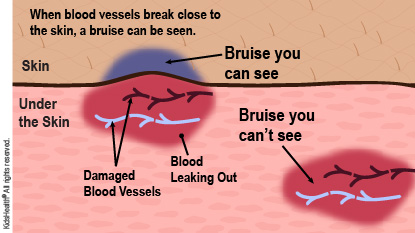Chest Contusion: How to Care for Your Child
A chest contusion (bruise) happens when a blow to the chest injures the skin and soft tissue under it. Small blood vessels can leak blood, causing red or purple marks on the skin. Deeper contusions of the chest may involve the muscles and ribs and take longer to heal. Health care providers can't see deep bruises, but they may feel a lump or swelling in the injured area. As contusions heal, they turn different colors before fading away. Most go away after 2 weeks.


-
Let your child rest as needed.
-
Encourage your child to take deep breaths.
-
Reduce the pain and swelling of the contusion:
-
After 2 days, a heating pad wrapped in a towel can help some bruises heal. Talk to your health care provider to make sure this is OK for your child's injury.
-
You can give medicine for pain if your health care provider says it's OK. Use these medicines exactly as directed:
-
acetaminophen (such as Tylenol® or a store brand)
-
OR
-
ibuprofen (such as Advil®, Motrin®, or a store brand). Do not give to babies under 6 months old.
-
Follow your health care provider's directions about when your child can return to contact sports or rough play.


Your child:

How do health care providers diagnose a chest contusion? Health care providers carefully examine the injured area and ask about what happened. If the health care provider has concerns about a different type of injury, your child may need to have X-rays.
How do chest contusions happen? A chest contusion can happen from:
Can contusions be prevented? Yes, avoiding injuries can prevent some contusions. Follow these tips:
-
Keep floors free of clutter to avoid falls.
-
Take precautions during contact sports.
-
Always use seatbelts in the car.